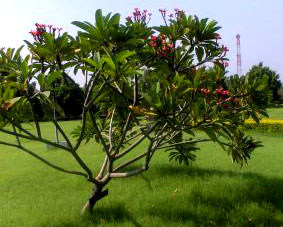Plumeria rubra
Franigpani
A distinctive tree known for its iconic flowers.
|
| Features: |
Fragrant, iconic flowers. Unusual growth habit. |
| Applications: |
Specimen tree for garden beds, containers, warm coastal sites. Non-invasive roots. |
| Description |
The sweet smell and the simple beauty of the Frangipani flower has accorded this plant its own place in gardens and landscapes. Growing slowly into a spreading shrub or small tree, its fleshy, digital branches are themselves quite unique, lined starkly with green deciduous leaves which cast insignificant shade.. The fragrant flowers vary in colour from warm pinks through to yellow-centred white blooms that can last from November through to May. Originally from tropical central America, the Frangipani needs the warm climate of the tropical and subtropical regions of WA to thrive - many can be seen around metropolitan Perth and further north. With well-drained soil and a warm (frost-free) climate, the Frangipani is tolerant of most other conditions - salt and drought tolerant, handles acidic and alkaline soils and tolerates harsh sites and urban conditions. Choose an appropriate site - its limbs can break under contact and its non-invasive root system may mean younger, less established plants are less stable. Prune limbs to encourage multiple sprouts and a denser shape, or prune to trunk for a more upright open habit. |
| Availability: |
Champion Lakes : In production |
| Mature height: |
2-8 |
| Mature spread: |
2-5 |
| Canopy: |
Open, spreading and domed with age. Limited shade. |
| Growth rate: |
Slow |
| Cautions: |
Sap is poisonous and an irritant. Limbs can break under contact. |
| Tolerances: |
Salt and coastal conditions. Drought tolerant. Hot and harsh sites. |
| Sun demands: |
Best in full sun but tolerating some shade |
| Soil demands: |
Most well-drained soils |
| Water demands: |
Low. Avoid over-watering during cooler months when |
| Native or Exotic: |
Exotic |
| Leaf habit: |
Deciduous |
| Family: |
Apocynaceae |
| |
|
|




|
Back to Search
Additional references and recommended reading:
Boland, D. J. et al (2006) "Forest Trees of Australia" 5th Edition, Australia: CSIRO Publishing.
Gilman, Edward F. (1997) "Trees for Urban and Suburban Landscapes", Florida: Delmar Cengage Learning.
Lorenz von Ehren "Von Ehren Manual" 2nd Edition, Hamburg.
Rushforth, K. (2001) "Easy Tree Guide, Britain and Europe", London: Aurum Press.
Urban Forests Ecosystems Institute, "SelecTree - A Tree Selection Guide" retrieved from http://selectree.calpoly.edu/treelist.lasso 2009.
Disclaimer:
Torbay Treefarmers makes all information on this website available in good faith to customers, based on experience, general knowledge and research and in so doing, makes no guarantee in any way about the accuracy or usefulness of this information, nor is any warranty made or inferred by the supply of this information, nor can Torbay Treefarmers be held responsible or accountable for any loss, harm or damage that may arise from the use or availability of any information on this website.
|